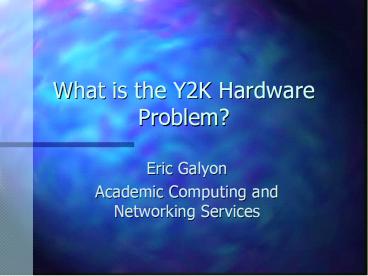What is the Y2K Hardware Problem - PowerPoint PPT Presentation
1 / 23
Title:
What is the Y2K Hardware Problem
Description:
Will set the date to 1900 during the leap year powered off test. How to fix the problem. The appropriate fix depends on which type of BIOS the machine has and whether ... – PowerPoint PPT presentation
Number of Views:83
Avg rating:3.0/5.0
Title: What is the Y2K Hardware Problem
1
What is the Y2K Hardware Problem?
- Eric Galyon
- Academic Computing and Networking Services
2
Objectives
- Inform everyone about the cause of the problem
- Explain what exactly happens when the problem
occurs - Discuss the recommended solutions to the problem
3
The Three Clocks
- RTC (Real Time Clock)
- BIOS
- Operating System Clock
4
How are the clocks set?
- The computer battery runs the RTC while the
computer is off - At startup, the BIOS reads the RTC to set its
time - At startup, the OS reads the BIOS to set its date
5
Where is the problem?
- The RTC rarely changes to the year 2000
- Newer BIOSs check the RTC for the date 1900 and
automatically set the year to 2000, older BIOSs
do not - The OS receives its initial time from the BIOS
6
What should happen (with a compliant BIOS)?
- The RTC will typically not roll over to the year
2000 - When the machine is started on or after January
1st, 2000, the BIOS automatically changes the
date to 2000 - The operating system will receive the correct
date from the BIOS
7
The four types of BIOSs and their failures
- Compliant BIOS
- Typical Non-Compliant BIOS
- Restricted Range BIOS
- 1900 BIOS
8
Compliant Bios
- Automatically rolls over to the year 2000 when
the computer is left on - Automatically sets the RTC to the correct value
the first time the machine is started after the
year 2000
9
Typical Non-Compliant BIOS
- Does not automatically roll over to the year
2000 - Once the date has been set in the BIOS, the BIOS
will hold the date and work properly. It may
not, however, recognize the year 2000 as a leap
year
10
Restricted Range BIOS
- Only recognizes dates between 1984 and 1999
- Will not hold the year 2000 even after it is set
the date must be reset after every reboot
11
1900 BIOS
- Very old and rare BIOS that defaults to 1900
after every reboot - Will not hold the year 2000 even after it is set
the date must be reset after every reboot
12
How to tell which BIOS a machine has
- Compliant BIOS
- Will pass every test
13
How to tell which BIOS a machine has
- Typical Non-Compliant BIOS
- Will fail the powered on and powered off roll
over test - Will not fail the leap year tests
14
How to tell which BIOS a machine has
- Restricted Range BIOS
- Will fail the powered on and powered off roll
over test - Will set the date to 1984 during the leap year
powered off test
15
How to tell which BIOS a machine has
- 1900 BIOS
- Will fail the powered on and powered off roll
over test - Will set the date to 1900 during the leap year
powered off test
16
How to fix the problem
- The appropriate fix depends on which type of BIOS
the machine has and whether the machine is
mission critical (a file server or a computer
that controls a piece of hardware) or a standard
business machine
17
Fixing a Mission Critical machine
- Upgrading is the best policy
18
Fixing a Non Mission Critical machine
- Compliant BIOS
- No action is necessary for hardware compliance
19
Fixing a Non Mission Critical machine
- Typical Non-Compliant BIOS
- Use the TF2000 software solution
- The solution will prevent the user from having to
manually set the date after the year 2000
20
Fixing a Non Mission Critical machine
- Restricted Range BIOS
- Upgrade the machine or BIOS
- The TF2000 software solution can be used but is
not recommended
21
Fixing a Non Mission Critical machine
- 1900 BIOS
- Upgrade the machine or BIOS
- The TF2000 software solution can be used but is
not recommended
22
Summery
- Most year 2000 problems originate from the BIOS
- Mission critical machines should be replaced, not
patched - Machines with abnormally non-compliant BIOSs
should be replaced, not patched
23
Dont Forget!!!
- Even brand new machines can have non-compliant
BIOS - Hardware compliance is only the first step, to be
truly year 2000 compliant you must also check the
operating system and applications































